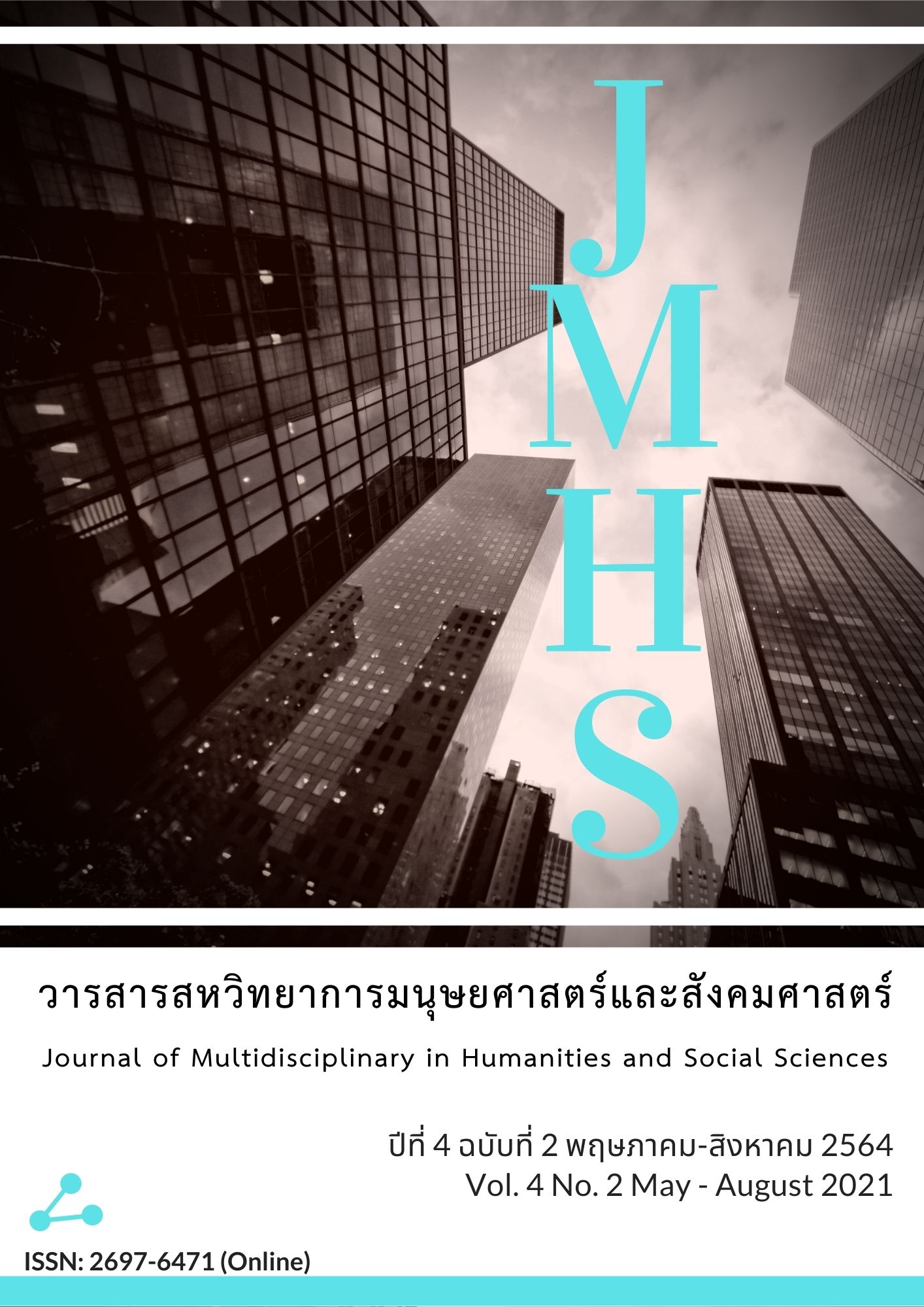The Influence of Causal Factors Purchasing Intention Sport Clothes on Facebook Fanpage of Consumers in Thailand
Main Article Content
Abstract
The objectives of this research were to develop and validate the consistency a causal of relationship model of purchasing intention sport clothes on the Facebook fanpage of consumers in Thailand. This study was a quantitative research. The sample group consisted of 480 people who have been bought new or second hand sport clothes through the Facebook fanpage “Sueapha Kila Mue 2”. The tools used in the research was online questionnaires. The statistics used in data analysis were frequency, percentage and structural equation model.
The findings indicated that the structural equation model was used to analyze causal relationships to find the path to the causal influence of the variables consisting of 4 components: 1) Perceived ease, 2) Perceived security, 3) Trust, and 4) Purchase Intention and the model was consistent with the empirical data to a great extent. The statistic showed the Chi-square statistics goodness fit test (χ2) = 193.31, degrees of freedom (df) = 1.37, CMIN / DF = 141, GFI = 0.96, AGFI = 0.94, SRMR = 0.03, RMSEA = 0.02 The final is predictive coefficient of 0.89, indicating that the variables in the model can explain the variance of the Purchase Intention of sport clothes on Facebook fanpage by 89 percent. It was found that the Consumer Trust were the most influence on Purchasing Intention sport clothes on the Facebook fanpage of consumers in Thailand. The results of this research are useful for entrepreneurs, sport clothes through the Facebook fanpage are utilized to a marketing plan and create marketing strategies that are suitable for consumers. Resulting in purchasing intention to sport clothes on the Facebook fanpage in the future.
Article Details
Views and opinions appearing in the Journal it is the responsibility of the author of the article, and does not constitute the view and responsibility of the editorial team.
References
กริช แรงสูงเนิน. (2554). การวิเคราะห์ปัจจัยด้วย SPSS และ AMOS เพื่อการวิจัย. กรุงเทพฯ: ซีเอ็ดยูเคชั่น.
ชไมพร กาญจนกิจสกุล. (2555). ระเบียบวิธีวิจัยทางสังคมศาสตร์. ตาก: โพรเจ็คท์ไฟฟ์-โฟว์.
นฤมล ยีมะลี. (2560). การรับรู้ความง่ายต่อการใช้งาน การรับรู้ประโยชน์ และการสื่อสารแบบปากต่อปากผ่านทางอิเล็กทรอนิกส์ (E-word of Mouth) ที่มีอิทธิพลต่อความตั้งใจใช้บริการแอปพลิเคชันชมภาพยนตร์ และซีรีส์ของผู้บริโภคกลุ่ม Gen Y ในจังหวัดกรุงเทพมหานคร (การศึกษาค้นคว้าอิสระบริหารธุรกิจมหาบัณฑิต). มหาวิทยาลัยกรุงเทพ.
พนัชกร สิมะขจรบุญ. (2561). อิทธิพลการสื่อสารความรับผิดชอบต่อสังคมที่มีต่อความตั้งใจซื้อสินค้าร้านสะดวกซื้อเซเว่นอีเลฟเว่น. วารสารวิชาการ, มหาวิทยาลัยศิลปากร, 12(4), 1365-1389.
พิชญ์ปิยา เพ็งผ่อง. (2558). การยอมรับเทคโนโลยี ความไว้วางใจ การเน้นราคาประหยัด และความแปลกใหม่ที่ส่งผลต่อความตั้งใจซื้อตั๋วเครื่องบินออนไลน์ของสายการบินต้นทุนต่ำของผู้บริโภคในกรุงเทพมหานคร(การศึกษาค้นคว้าอิสระบริหารธุรกิจมหาบัณฑิต). มหาวิทยาลัยกรุงเทพ.
พิศุทธิ์ อุปถัมภ์. (2556). ความไว้วางใจและลักษณะธุรกิจผ่านสื่อสังคม ออนไลน์ที่ส่งผลต่อความตั้งใจซื้อสินค้าผ่านสื่อสังคมออนไลน์(การศึกษาค้นคว้าอิสระบริหารธุรกิจมหาบัณฑิต). มหาวิทยาลัยกรุงเทพ.
ภาวุธ พงษ์วิทยภานุ. (2555). ความรู้เบื้องต้น E-commerce และ E-commerce คู่มือประกอบพาณิชย์อิเล็กทรอนิกส์. กรุงเทพฯ: สมาคมผู้ประกอบการพาณิชย์อิเล็กทรอนิกส์ไทย.
ภูมิภควัธจ์ ภูมพงศ์คชศร, จอมภัค จันทะคัต และ อัจฉราพรรณ ตั้งจาตุรโสภณ. (2562). ปัจจัยที่มีผลต่อการรับรู้ความปลอดภัยในการใช้ Application Mobile Banking ในเขตจังหวัดชลบุรี. วารสารสมาคมนักวิจัย, 24(3), 362-385.
สุธาสินี ตุลานนท์. (2562). การยอมรับเทคโนโลยีที่มีผลต่อการตัดสินใจซื้อสินค้าออนไลน์ของผู้สูงอายุ(วิทยานิพนธ์บริหารธุรกิจมหาบัณฑิต). มหาวิทยาลัยนเรศวร.
สุนันทา หลบภัย. (2558). การรับรู้ถึงความปลอดภัย ประโยชน์การใช้งาน และความง่ายในการใช้งานที่มีผลต่อการใช้บริการชําระเงินผ่านอุปกรณ์สื่อสารเคลื่อนที่ของผู้บริโภคในเขตกรุงเทพมหานคร(การศึกษาค้นคว้าอิสระบริหารธุรกิจมหาบัณฑิต). มหาวิทยาลัยกรุงเทพ.
Beldad, A., Jong, D. M., & Steehouder, M. (2010). How Shall I Trust the Faceless and the Intangible: A Literature Review on the Antecedents of Online Trust. Computers in Human Behavior, 26(5), 857–869.
Davis, F. D., Bagozzi, R. P., & Warshaw, P. R. (1989). User Acceptance of Computer Technology: A Comparison of Two Theoretical Models. Management Science, 35(8), 982-1003.
Hajli, M. N. (2014). A Study of the Impact of Social Media on Consumers. International Journal of Market Research, 56(3), 387-404.
Heijden, H. V. D. (2004). User Acceptance of Hedonic Information Systems. MIS Quarterly, 28(4), 695-704.
Hoelter, J. W. (1983). The Analysis of Covariance Structure: Goodness-of-Fit Indices. Sociological Method and Research, 11(3), 325-344.
Kim, D., Ferrin, D., & Rao, R. (2008). A Trust-Based Consumer Decision-Making Model in Electronic Commerce: The Role of Trust, Perceived Risk, and Their Antecedents. Decision support systems, 44(2), 544- 564.
Kim, M. S., & James, J. (2016). The Theory of Planned Behaviour and Intention of Purchase Sport Team Licensed Merchandise. Sport, Business and Management. An International Journal, 6(2), 228-243.
Kline, R. B. (2011). Principles and Practice of Structural Equation Modeling. (3rd ed.). New York: The Guilford Press.
Sayreya. (2011). Facebook Fan Page สร้างตัวตนบนโลกออนไลน์. สืบค้นเมื่อ 20 ธันวาคม 2563, จาก https://blog.lnw.co.th/2011/09/27/facebook-fan-page
Sembada, A. Y., & Koay, K. Y. (2019). How Perceived Behavioral Control Affects Trust to Purchase in Social Media Stores. Journal of Business Research, 130, 574-582. DOI: 10.1016/j.jbusres.2019.09.028
Shin, D. (2010). Analysis of Online Social Networks: A Cross-National Study. Online Inform, 34(3), 473-495.
Thai Business Search. (2563). Social Media ที่จำเป็นในการตลาดออนไลน์. สืบค้นเมื่อ 20 ธันวาคม 2563, จาก https://mandalasystem.com/blog/th/61/social-media-08092020


